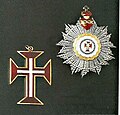Order of Christ (Brazil)
The Brazilian Order of Christ ( pt . : Imperial Ordem de Nosso Senhor Jesus Cristo ) is a " courtly knightly order ", which was founded on December 7, 1822 by Emperor Pedro I of Brazil . It is based on the Portuguese Order of Christ , which was founded in 1318 by King Dionysus of Portugal and was founded by Pope John XXII. (1316-1319) was approved. The order was given as a badge of honor to aristocrats of the Brazilian Empire who had made a special contribution to the expansion of the Roman Catholic Church , humanity and the Brazilian Empire. After the Brazilian Emperor Pedro II lost the throne on November 15, 1889, the award of the order was suspended on March 22, 1890 as the Brazilian national order by the new government of the First Republic of Brazil. The members of the house have since held the title of Prince or Princess of Orléans and Bragança. As early as 1889, Emperor Pedro II had declared the Order of Christ as a courtly house order, which can now be awarded by the respective boss of the house of Orleans and Bragança.
Emergence
The Portuguese colony of Brazil was founded in 1815 in personal union with the Kingdom of Portugal by King John VI. Portugal rules. His son Dom Pedro moved to Brazil in 1815. On September 7, 1822, Brazil declared its independence from Portugal and was proclaimed the Brazilian Empire. Dom Pedro took over the rule as Emperor Pedro I of Brazil. In 1823 his father gave him the right to award titles of nobility and to take over the old Portuguese Order of Christ. Emperor Pedro I became the first Grand Master of the Brazilian Order of Christ. After the death of his father, he became King Pedro IV of Portugal, also Grand Master of the Portuguese Order of Christ. In 1843 the statutes of the order were reformed by Emperor Pedro II, the previous military order became an imperial-national Brazilian order.
Regulations
With the renewed regulations of 1861, the award guidelines and the award authorization were established. An honorable life was assumed as a prerequisite and the award honored the commitment to national righteousness. A distinction was made between the award of the service in the Roman Catholic Church and commitment to state issues. The award was made on the proposal of the emperor, who carried out the award in consultation with the responsible ministers . Furthermore, Brazilian citizens had the right to propose, after a given examination and approval process, the order could be handed over by the emperor, local representatives or bishops . The award of knighthood was lifelong, but it could be withdrawn if fundamental laws were violated.
Order classes
The Order of Christ is divided into the following classes: Grand Cross , Commander's Cross and Knight's Cross . The Grand Cross is only awarded to a total of twelve bearers, with the exception of family members. The winners of the Commander's Cross and the Knight's Cross are not limited. The wearing of the collar with sash is reserved for the Grand Master of the Order of Christ.
The design of the order is based in principle on the Order of Christ from Portugal, for external differentiation it was provided with a stylized crown of Brazil and ribbons of different colors. The coat of arms of the order differs for military and civil dignitaries.
Grand Master of the Brazilian Order of Christ
The first grandmaster was Emperor Pedro I, followed by his son Emperor Pedro II. He was then followed as head of the house by his daughter Isabella as Imperial Princess of Brazil, Princess of Orléans and Bragança. In the succession 1921-1981, Prince Pedro Henrique (Peter Heinrich) of Orléans and Bragança took over the office, he was the great-grandson of Isabella. He was followed in 1981 as the acting head of the house, Prince Luiz (Ludwig) in the office of Grand Master.
See also
Web links
- The Brazilian Order of Christ (English)
- Casa Imperial do Brasil - Condecorações do Brasil Real e Imperial. In: org.br. www.monarquia.org.br, accessed January 29, 2018 (Portuguese).






